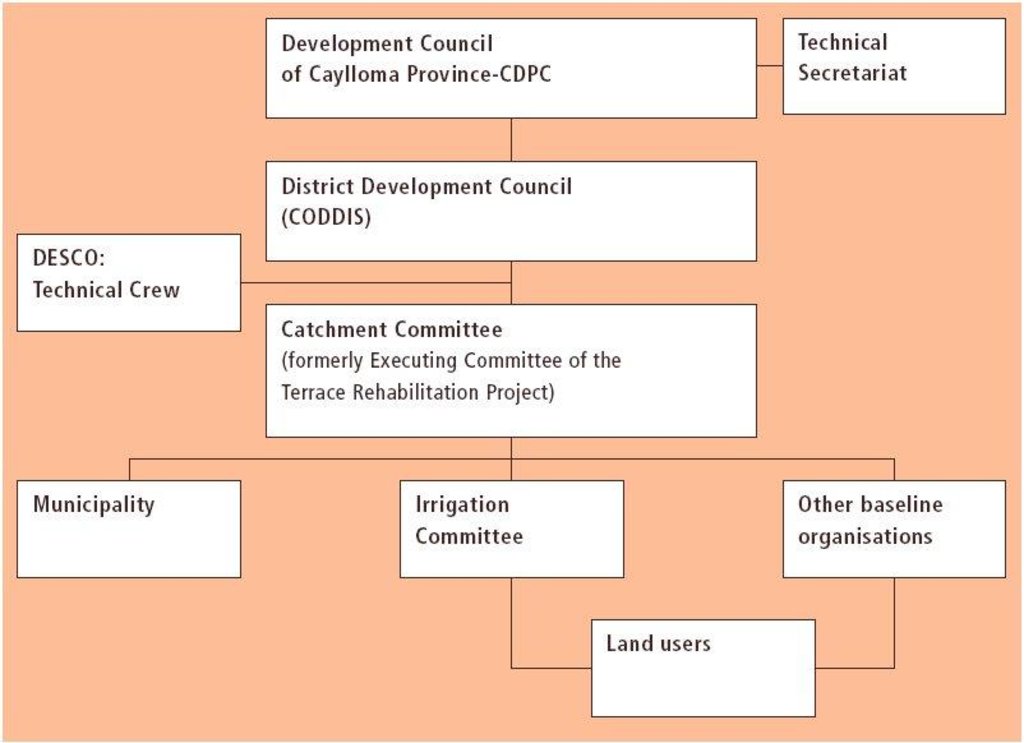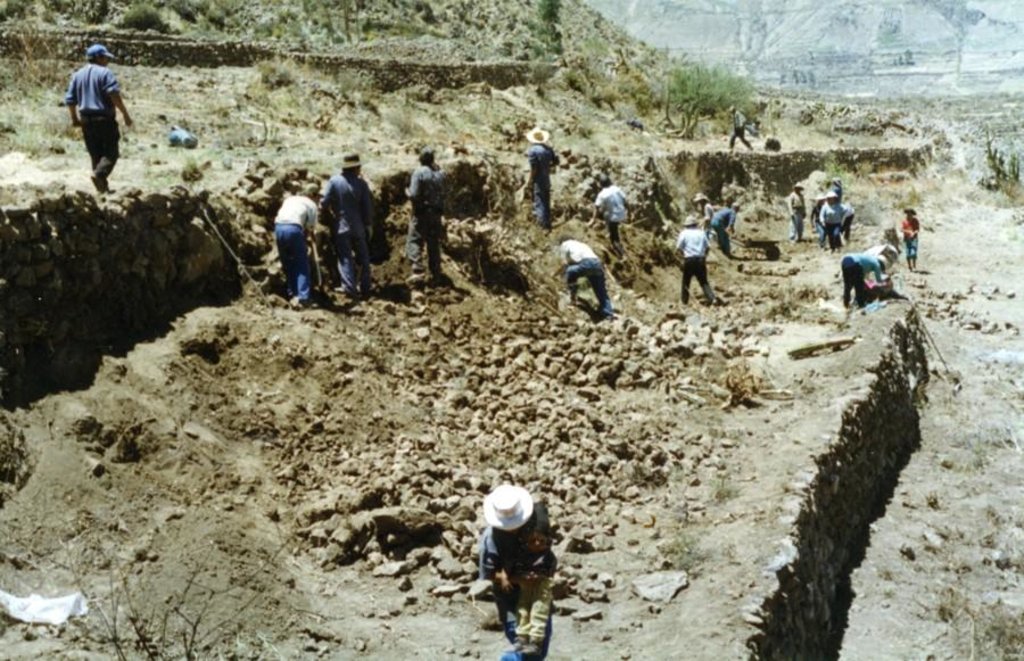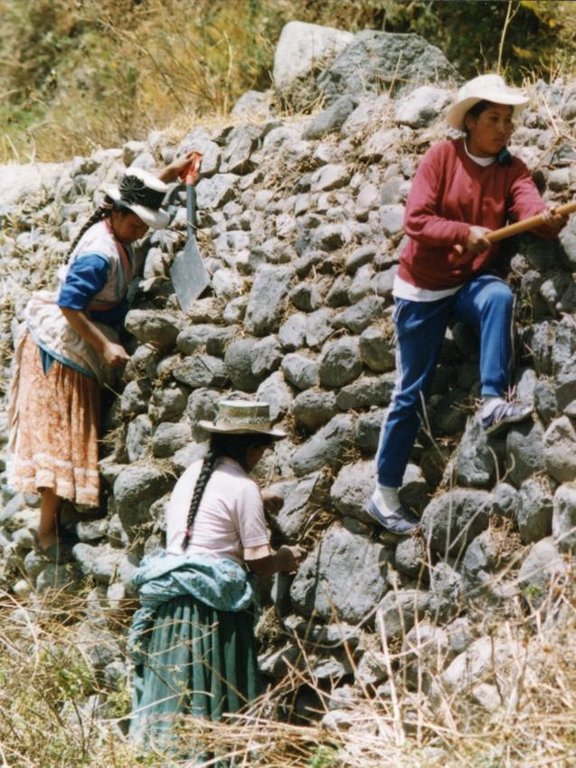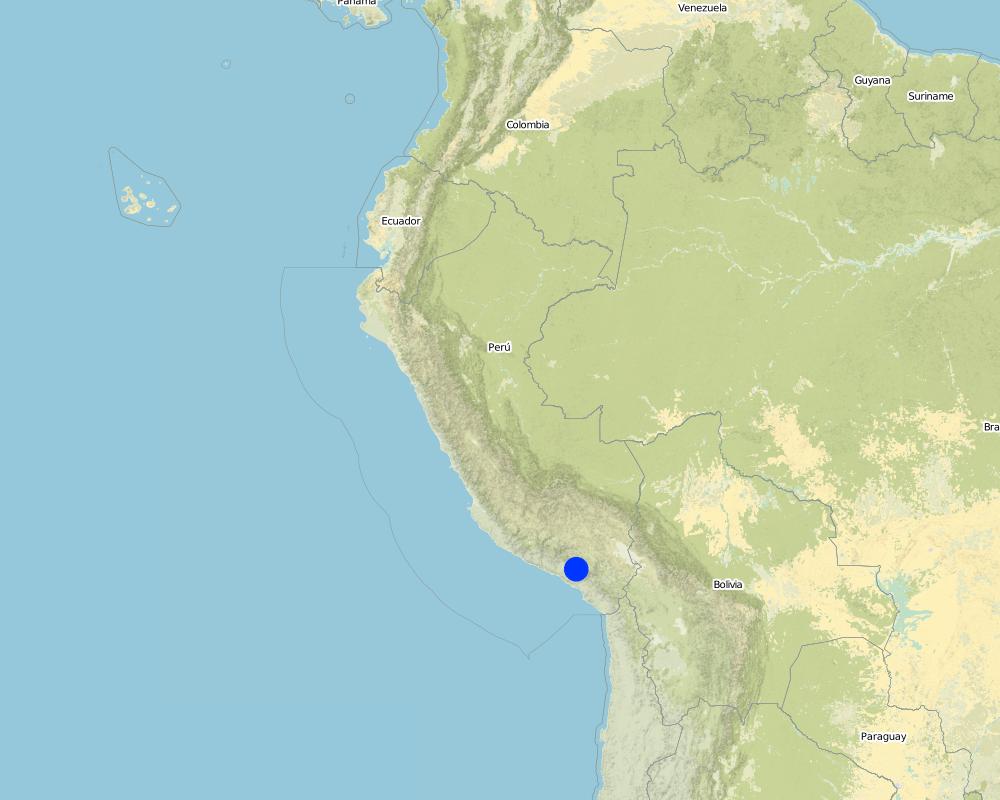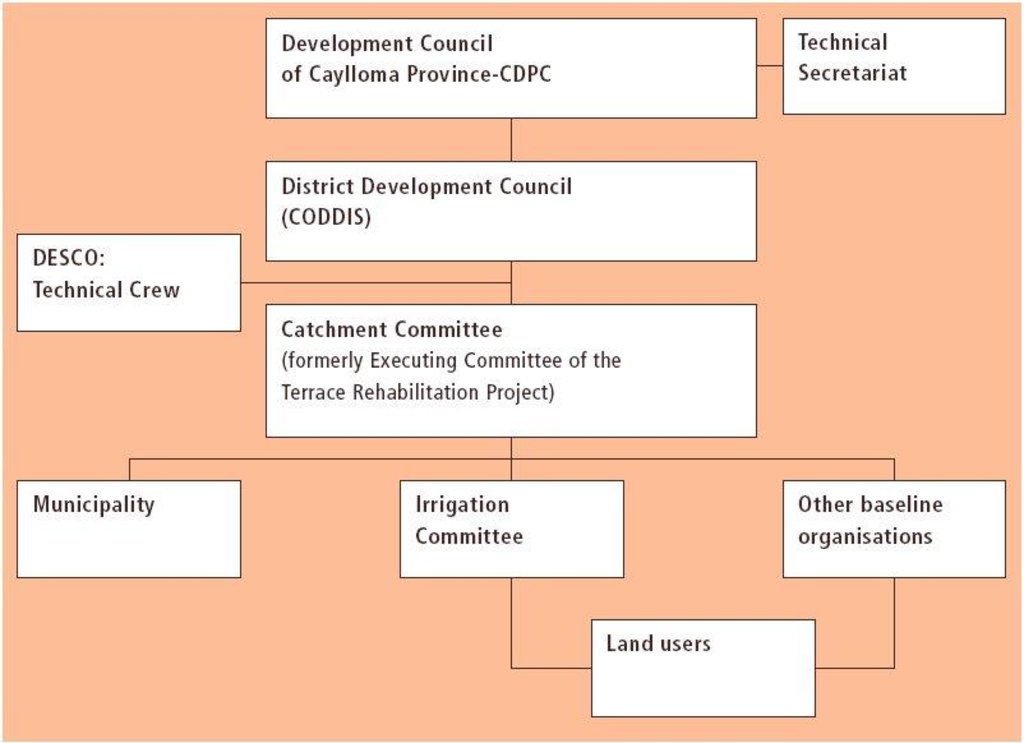Participatory catchment rehabilitation (Participación comunitaria para la rehabilitación de cuencas) [Peru]
- Criação:
- Atualização:
- Compilador/a: Philippe Zahner
- Editor: –
- Revisor: Fabian Ottiger
approaches_2347 - Peru
Veja as seções
Expandir tudo Recolher tudo1. Informação geral
1.2 Detalhes do contato das pessoas capacitadas e instituições envolvidas na avaliação e documentação da abordagem
Especialista em GST:
Marquina Rodolfo
descolca@terra.com.pe
Centro de Estudios y Promocion del Desarrollo - DESCO
Calle Malaga Grenet No. 678 Umacollo, Arequipa
Peru
Especialista em GST:
Marcacuzco Aquilino P Mejia
Centro de Estudios y Promocion del Desarrollo - DESCO
Calle Malaga Grenet No. 678 Umacollo, Arequipa
Peru
Nome da(s) instituição(ões) que facilitou(ram) a documentação/avaliação da Abordagem (se relevante)
Swiss Agency for Development and Cooperation (DEZA / COSUDE / DDC / SDC) - SuíçaNome da(s) instituição(ões) que facilitou(ram) a documentação/avaliação da Abordagem (se relevante)
Centro de Estudios y Promoción del Desarrollo (DESCO) - Peru1.3 Condições em relação ao uso da informação documentada através de WOCAT
O/a compilador/a e a(s) pessoa(s) capacitada(s) aceitam as condições relativas ao uso de dados documentados através da WOCAT:
Sim
1.4 Referência ao(s) questionário(s) sobre tecnologias da GST
2. Descrição da abordagem de GST
2.1 Descrição curta da abordagem
Promoting the rehabilitation of ancient terrace systems based on a systematic watershed management approach.
2.2 Descrição detalhada da abordagem
Descrição detalhada da abordagem:
Aims / objectives: The Center for Studies and Promotion of Development - DESCO, a Peruvian NGO, started the Terrace Rehabilitation Project in 1993 to re-establish ancient terracing and irrigation practices that had largely been lost. The project is part of a general integrated development programme. Its overall purpose is to restore the productive capacity of terraced cropland, and to generate better living standards in the Colca valley. The project has the following specific objectives: (1) to increase the productive infrastructure through soil conservation and better use and management of existing water resources; (2) to increase levels of production; (3) to stimulate people in soil conservation and land management; and (4) to encourage/promote relevant local institutions. For implementation, a systematic watershed management approach was introduced. The catchment was considered the basic unit for development planning. Physical and socio-economic baseline studies were carried out. A strong community-based organisation, the catchment committee, was then founded. This consisted of representatives of major local grassroots organisations (irrigation committee, farmers' community, mothers' club etc). Responsibilities, commitments and rules were defined. Committee meetings and land user assemblies were the entities for planning, organisation and execution of project activities. DESCO initiated a process of 'concerted planning' in collaboration with other private and public institutions in Caylloma province.
Methods: In summary the project stages comprised: (1) project planning; (2) baseline studies; (3) catchment management plan; (4) constitution of the executive committee; (5) concerted planning of district development; and (6) organisation, execution, technical assistance and follow-up activities. Land users were required to participate in training courses and in fieldwork, to provide local materials and their own tools, and to fulfil duties within the organisations. Leaders and directors of grassroots organisations were responsible for planning and organisation of activities - implementation, training and follow-up - and for control and administration of project materials and inputs. The directors were also elected as representatives in the District Development Councils to participate in the evaluation and monitoring activities of the project.
2.3 Fotos da abordagem
2.5 País/região/locais onde a abordagem foi aplicada
País:
Peru
Região/Estado/Província:
Rio Colca
Especificação adicional de localização:
Arequipa, Peru
Map
×2.6 Datas de início e término da abordagem
Indique o ano de início:
1993
2.7 Tipo de abordagem
- Baseado em projeto/programa
2.8 Principais metas/objetivos da abordagem
- to achieve higher levels of agricultural production and productivity through integrated development/management of soil and water resources. - to build capacity for planning, organisation and implementation of development activities
The SLM Approach addressed the following problems: - lack of employment opportunities/depopulation of rural areas. - lack of planning and action in 'concerted development' - little value associated with terrace rehabilitation. - low and unequal participation of women in field work. - general impoverishment of land users
2.9 Condição que propiciam ou inibem a implementação de tecnologia/tecnologias aplicada(s) segundo a abordagem
Normas e valores sociais/culturais/religiosos
- Inibitivo
Women were treated unequally in terms of opportunities and salaries
Treatment through the SLM Approach: Equal treatment in salaries and better opportunities were ensured for women.
Disponibilidade/acesso a recursos e serviços financeiros
- Inibitivo
The poorest land users lacked the money to invest in terrace rehabilitation.
Treatment through the SLM Approach: Manual labour and tools were subsidised.
Quadro institucional
- Inibitivo
Coordination of planning and activities was lacking between different institutions and projects.
Treatment through the SLM Approach: District Development Councils (CODDIS) were strengthened as entities for coordination and concerted action.
Quadro jurídico (posse de terra, direitos de uso da terra e da água)
- Inibitivo
There was a lack of legal (registered) institutions to coordinate planning and strategies for sustainable land use at community level.
Treatment through the SLM Approach: An active effort was made to promote legalisation of, and give support to, grassroots organisations (eg Union of Land Users).
Conhecimento sobre GST, acesso a suporte técnico
- Inibitivo
Local specialists in terrace rehabilitation and for construction supervision were lacking.
Treatment through the SLM Approach: Training and competitions were organised to develop skills and select the best.
Outro
- Inibitivo
Economical: Investment in cash crops was a problem for poor smallholders.
Treatment through the SLM Approach: Training/technical assistance was given for more profitable crops e.g potatoes, beans and peas.
3. Participação e papel das partes interessadas envolvidas
3.1 Partes interessadas envolvidas na abordagem e seus papéis
- Usuários de terra/comunidades locais
There were no differences in terms of salaries, but there were in terms of job opportunities: in a working group of 20 persons, typically only 5 women were contracted as terrace rehabilitation is very heavy work.
- Especialistas em GST/ consultor agrícola
- Professores/alunos/estudantes
- Governo nacional (planejadores, responsáveis pelas decisões)
3.2 Envolvimento do usuários de terra/comunidades locais nas diferentes fases da abordagem
| Envolvimento do usuários de terra/comunidades locais | Especifique quem estava envolvido e descreva as atividades | |
|---|---|---|
| Iniciação/motivação | Participativo | interviews/questionnaires, workshops/seminars, public meetings |
| Planejamento | Automobilização | workshops/seminars; assemblies for decision making, workshops for local concerted planning |
| Implementação | Participativo | casual labour, responsibility for minor steps; casual labour, responsibility for minor steps (land users in general); responsibility for major steps (leaders) |
| Monitoramento/avaliação | Participativo | workshop/seminars, reporting, measurements/observations, interviews/questionnaires, public meetings; workshops, measurements/observations (directors of baseline organisations/leaders), reports (directors), interviews (directors/teachers), public meetings (land users) |
| Research | Nenhum | none |
3.3 Fluxograma (se disponível)
Descrição:
District Development Council (CODDIS): social organisations, public and private institutions jointly prepare economic and social development plans in a participatory manner, and under the leadership o
3.4 Decisão sobre a seleção de tecnologia/tecnologias de GST
Especifique quem decidiu sobre a seleção de tecnologia/tecnologias a serem implementadas:
- Principalmente especialistas em GST, após consulta com usuários da terra
Explique:
the terraces were in an advanced stage of collapse and the local population did not have the means to reverse the process due to lack of economic resources.
Decisions on the method of implementing the SLM Technology were made by mainly by land users supported by SLM specialists. the technology is indigenous and adapted to the area. Evaluation workshops of, and activities permitting discussions on, the technology were carried out.
4. Suporte técnico, reforço das capacidades e gestão do conhecimento
4.1 Reforço das capacidades/ formação
Foi oferecida formação aos usuários da terra/outras partes interessadas?
Sim
Tipo de formação:
- Reuniões públicas
Tipo de formação:
- exchange of experiences
Assuntos abordados:
A training plan at three levels was drawn up, addressing the following target groups and topics: (1) Selected land users, leaders, supervisors: in-depth training on the interrelations between water, soil and plants; terrace and canal construction; institution/enterprise management; natural resource management, conservation practices, and crop production. (2) Directors of grassroots organisations
4.2 Serviço de consultoria
Os usuários de terra têm acesso a um serviço de consultoria?
Sim
Descreva/comentários:
Key elements: technical assistance and sustained follow-up, supervision by specialised engineers, evaluation (reflection) and systematisation of gained know-how and developed practices with different stakeholders, function; testing of rehabilitated structures; Capacity for extension continuation has been built up within the catchment committee. However PRONAMACHS, a governmental SWC programme, is limited
4.3 Fortalecimento da instituição (desenvolvimento organizacional)
As instituições foram fortalecidas ou estabelecidas através da abordagem?
- Sim, significativamente
Especifique a que nível (níveis) as instituições foram fortalecidas ou estabelecidas:
- Local
Especifique o tipo de apoio:
- Financeiro
- Reforço das capacidades/ formação
4.4 Monitoramento e avaliação
Monitoramento e avaliação são partes da abordagem?
Sim
Comentários:
technical aspects were regular monitored by 0 through measurements; indicators: improved structures, results of technology tests
socio-cultural aspects were ad hoc monitored by 0 through observations; indicators: land users changing attitudes of SWC
economic / production aspects were ad hoc monitored by 0 through measurements; indicators: crop production increase
area treated aspects were regular monitored by 0 through measurements; indicators: rehabilitated area
no. of land users involved aspects were regular monitored by 0 through measurements; indicators: number of households that benefited directly
management of Approach aspects were ad hoc monitored by 0 through observations; indicators: number of catchments rehabilitated with terraces and agroforestry
There were several changes in the Approach as a result of monitoring and evaluation: There were various changes/readjustments of the approach: eg the concerted planning through the Local Development Councils was incorporated 5 years after the initiation of the project.
4.5 Pesquisa
A pesquisa foi parte da abordagem?
Sim
Especifique os tópicos:
- Economia/Marketing
- Tecnologia
Dê mais detalhes e indique quem realizou a pesquisa:
Technology: research has been ongoing regarding functioning of the terrace and irrigation systems. Economy/commercialisation: research regarding agronomic production, catchment appraisals and market studies have been carried out for the main products of the area.
5. Financiamento e apoio material externo
5.1 Orçamento anual para o componente de GST da abordagem
Comentários (p. ex. principais fontes de recursos/principais doadores):
Approach costs were met by the following donors: international non-government (International NGO): 60.0%; government (national): 20.0%; local community / land user(s) (-): 20.0%
5.2 Apoio financeiro/material concedido aos usuários da terra
Os usuários da terra receberam apoio financeiro/material para a implementação de tecnologia/tecnologias?
Sim
5.3 Subsídios para entradas específicas (incluindo mão-de-obra)
- Equipamento
| Especifique quais entradas foram subsidiadas | Em que medida | Especifique os subsídios |
|---|---|---|
| Maquinário | Parcialmente financiado | A-frames, tape measures, motor drills, wheelbarrows, shovels, picks, steel bars, sledgehammers,hoes, and compressors |
| Ferramentas | Parcialmente financiado | |
- Agrícola
| Especifique quais entradas foram subsidiadas | Em que medida | Especifique os subsídios |
|---|---|---|
| Sementes | Totalmente financiado | Seedlings of tree species for establishment of the agroforestry component on terraces were produced in a project-owned nursery, and they were given free of charge to interested farmers |
Se a mão-de-obra pelos usuários da terra foi uma entrada substancial, isso foi:
- Pago em dinheiro
Comentários:
60% of the labour costs were met by the project.
5.4 Crédito
Foi concedido crédito segundo a abordagem para atividades de GST?
Sim
Especifique as condições (taxa de juros, reembolso, etc):
repayment conditions: Credit was provided by FONDESURCO to land users who participated in the rehabilitation project (for seed supply) with a lower interest rate than on the market. FONDESURCO is an NGO (of which DESCO is a member) specialised in microfinances in the rural sector..
5.5 Outros incentivos ou instrumentos
Foram utilizados outros incentivos ou instrumentos para promover a implementação das tecnologias de GST?
Sim
Caso afirmativo, especifique:
Support was provided to existing institutions (in the form of training, organisation and financial inputs). But with the formation of a catchment committee, an important grassroots organisation was built up.
6. Análise de impactos e declarações finais
6.1 Impactos da abordagem
A abordagem auxiliou os usuários da terra a implementar e manter as tecnologias de GST?
- Não
- Sim, pouco
- Sim, moderadamente
- Sim, significativamente
There have been great improvements: introduction of high-value crops; 100% of the area cultivable; reduction of irrigation frequency by 20% due to higher efficiency of water storage by the terraces; various other SWC benefits.
Did other land users / projects adopt the Approach?
- Não
- Sim, pouco
- Sim, moderadamente
- Sim, significativamente
A few other projects have adopted the approach: eg the project of the Banco de Vivienda PRATVIR in the Coporaque area; also 'Popular Cooperation' in Ichupampa (covering just 2 ha).
6.3 Atividades de sustentabilidade de abordagem
Os usuários da terra podem manter o que foi implementado através da abordagem (sem apoio externo)?
- Sim
Caso afirmativo, descreva como:
Land users can continue the activities without external support, using traditional systems of mutual help and new forms of local organisation (catchment committee). With increased income through integration of cash crops the maintenance of the structures can be sustained.
6.4 Pontos fortes/vantagens da abordagem
| Pontos fortes/vantagens/oportunidades na visão do/a compilador/a ou de outra pessoa capacitada |
|---|
| Complementary conservation practices have been integrated into the terraces system: agroforestry, improved fallow, etc (How to sustain/ enhance this strength: Training of land users in the advantages and disadvantages of these practices.) |
| nstitutional capacity building: strengthening of organisations; increased participation (How to sustain/ enhance this strength: Continue the training of leaders.) |
| SWC training and extension activities. (How to sustain/ enhance this strength: Create spaces and mechanisms for daily practice of important cultural rituals/customs.) |
| 80% of land users have changed attitudes towards SWC, and are convinced of the benefits of terrace rehabilitation (How to sustain/ enhance this strength: SWC training and extension activities.) |
| Human capacity building: 60 specialists trained in rehabilitation technology (How to sustain/ enhance this strength: Create opportunities to ensure continuation of their work.) |
| An effective systematic watershed management approach applied at catchment level (How to sustain/ enhance this strength: Other projects/institutions should apply this approach.) |
| Soil conservation activities integrated in the plans of 'concerted development' (How to sustain/ enhance this strength: Strengthening of the Local Development Councils (CODDIS).) |
6.5 Pontos fracos, desvantagens da tecnologia e formas de superá-los
| Pontos fracos/vantagens/riscos na visão do/a compilador/a ou de outra pessoa capacitada | Como eles podem ser superados? |
|---|---|
| Labour overload in the family | Better planning of work at the household level. |
| The approach requires the participation of all social and political stakeholders - which is practically impossible | Strengthen the Local Development Councils (CODDIS). |
| The generation of income encourages the purchase of industrialised products | More training regarding consumption of local products. |
| The economic incentives provided by the project affected the existing reciprocal relationships (eg labour exchange) | Cash for work incentives are sometimes useful to overcome labour constraints due to depopulation. |
| Small holdings and land fragmentation are constraints for cost-effective agriculture | Accelerate the process of land consolidation and entitlement. |
| Changes in leadership interrupt planned processes (of activities) | Permanent training to encourage leadership qualities. |
| Lack of a crop and irrigation plan for better water management | Elaboration and application of a plan. |
7. Referências e links
7.1 Métodos/fontes de informação
- visitas de campo, pesquisas de campo
- entrevistas com usuários de terras
Links e módulos
Expandir tudo Recolher tudoLinks
Não há links
Módulos
Não há módulos




